Some folk find regular monitors quite harsh on the eyes, and look to things like e-ink and RLCD screens to reduce eye strain and fatigue. Here's another option: the Eazeye monitor is designed to use ambient backlight, via a reflector panel behind a transmissive screen.
Where your traditional monitor blasts light through from behind the screen, often being the brightest thing in the room, E-ink and RLCD (reflective liquid crystal displays) are both a little easier on the eyes because they both chiefly reflect ambient light. And while both typically ship with helper lights you can switch on to use them in darker rooms, these lights shine down onto the screen and reflect back up rather than coming through from behind.
Both are expensive, though – a 25.3-inch Dasung E-Ink monitor will run you about US$1,700, and Sun Vision Display's RLCD monitor is about the same. And while some do say they're more relaxing to work with, both are a compromise as compared to the screens most of us are used to: they're naturally a lot dimmer, for starters.
E-ink is also either black and white, or has some rudimentary color capabilities, and it's pretty much useless for video thanks to slow refresh rates and a "ghosting" effect where pigment hasn't been cleared from the screen between frames. And RLCD, while it's color and much better for video, tends to struggle with reflective glare, viewing angle, low resolution, and it tends to require more ambient light than even e-ink.
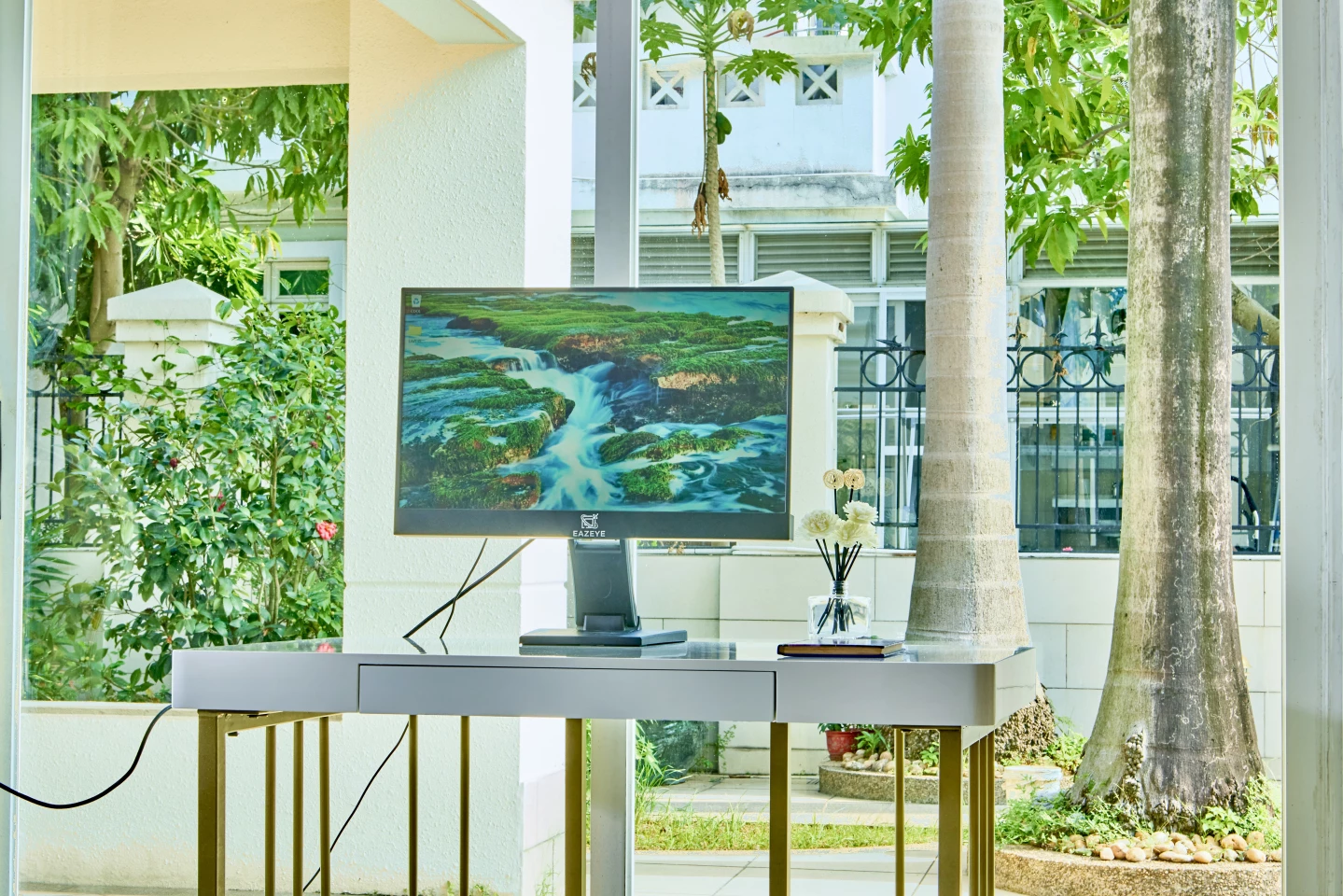
All of which is to say: neither of these low-eye-fatigue monitor options are going to blow anyone away when placed next to a traditional screen or used outside of their optimal conditions. And that's a key point to start from when looking at the Eazeye monitor.
Eazeye is the brainchild of 17-year-old high school student Louis Huang, who was searching for a more affordable way to build a low-eye-strain, low-power-consumption monitor option. He decided on a design that stays pretty similar to a regular screen, but makes use of ambient light in the backlighting.
Thus, all the circuit boards and whatnot are stored in a little box at the bottom, and the Eazeye monitor opens out like a book. In the front part are the frame, the LCD color-filtering screen, a few diffuser sheets and a translucent-ish LED light panel you can use as a backup light source, and the back part is simply a reflector panel designed to grab ambient light from above and reflect it through the LCD screen.
It's an odd-looking device, for sure, but the idea is that you can sit it in front of a window, or take it outside, and the sun itself can be your backlight. In terms of basic specs, it's a 24-inch monitor, 1080p resolution, with a 75-Hz max refresh rate and the capability to show a million-odd colors. It runs off 5 W of electricity, so about 1/15th as much as a regular monitor, and on launch today at Indiegogo, it's vastly less expensive than the others at $545.

Huang sent us a pre-production prototype to test ahead of launch. There are a few fairly typical pre-production issues with the unit – the stand is a little wobbly, for example, there's some odd electrical interference that makes my speakers buzz, and I've had to use a clothes peg to hold the reflector screen tight against the monitor, because the magnetic closure on the production units isn't in there yet. These are all known to the Eazeye team, and we have no reason to believe they won't be taken care of by the time customer units start shipping, so we won't dwell on them.
As to the naturally-backlit concept itself, well, I can give a few first impressions, but only from the perspective of somebody that doesn't particularly struggle with eye strain when dealing with regular ol' monitors.
Let's start off with what you might call night mode, as in the picture above, with the back panel sandwiched tight up against the main screen and the LED backup-backlight on. In this configuration, with brightness set to 100, the Eazeye screen is somewhat dimmer than either of my regular monitors (running at around 30% brightness), and considerably yellower even with the blues dialed up to 100, since the backlight is a warm 4,000K color temperature.
"We chose this 4,000K LED strip," Huang tells us over a video call, "because a), it limits blue light exposure, and b), it'll match with typical room lighting, which is about 4,000 K." As such, the idea is that it should blend in better with what's around it, forcing less of an adjustment for your eyes and brain.
That said, it's very usable in this configuration, including video which looks nice and smooth. I wouldn't use it for photo or video editing, partially because of the warm color cast and partially because it's hard to see much detail in the darker parts of the picture, but that's not the point of a screen like this anyway.
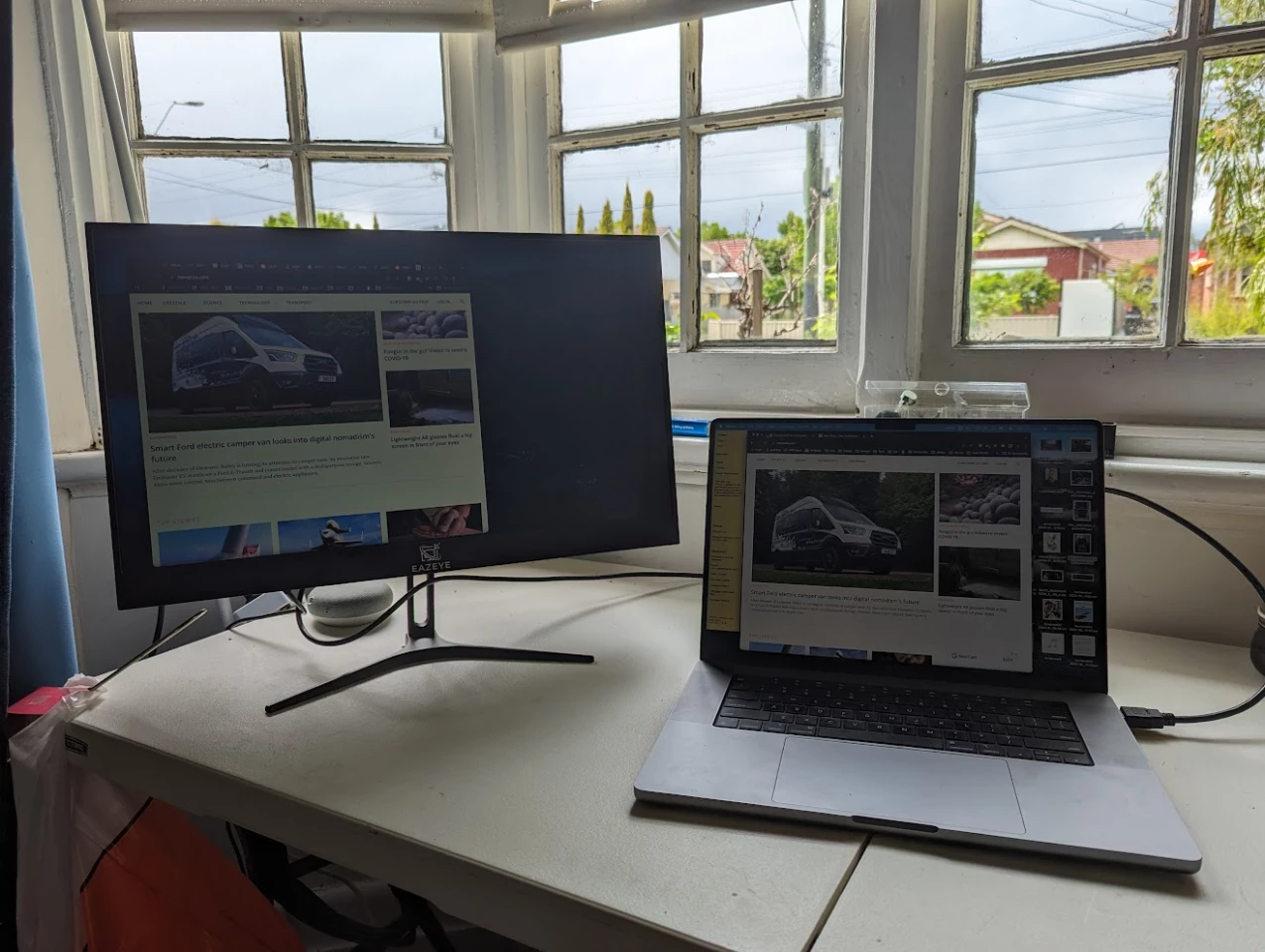
Moving into "day mode," opening out the reflector panel and positioning the Eazeye under a window, the ambient light reflecting off the back panel brightens things up to a degree. But it's still hard to see detail in darker areas, and the glare from outside the window will always be brighter than what makes it through the filter of the LCD panel. That effect tends to shut my irises down and make everything else look darker. I have to say, I don't find that arrangement particularly relaxing on the eyes.
"There's a simple solution for that," says Huang. "You can put the blinds down around the monitor, or try tilting it to different angles. But that's something we have to deal with when we're working with natural light. It's not perfect, but none of the other solutions in the market are perfect either."
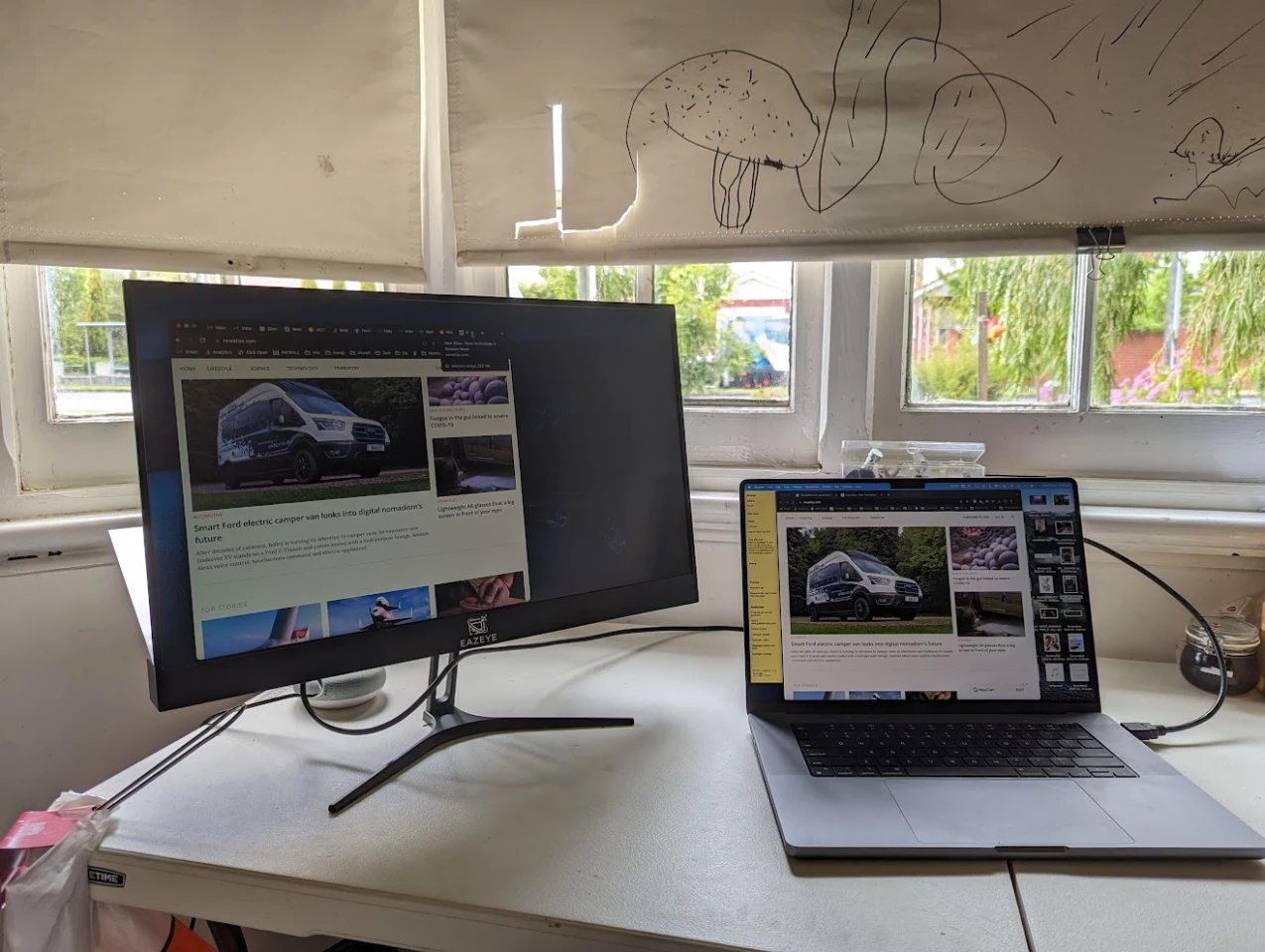
As for working outside, well, I can't say I'm particularly enamored of that experience either. As with working at a window, you need to choose your angles to make sure there's something dark behind your monitor, or else the background will be much brighter than what makes it through the LCD. Also, it's been windy here, and I haven't been able to do much outside without worrying the screen will blow over.
And while it doesn't chew much power, it's not quite efficient enough to run off a USB port – so you've got to drag a power brick out with you, and an extension lead or portable battery. Mind you, as Huang points out, if you do go to these lengths, your portable battery will last much, much longer with this monitor than a regular one.
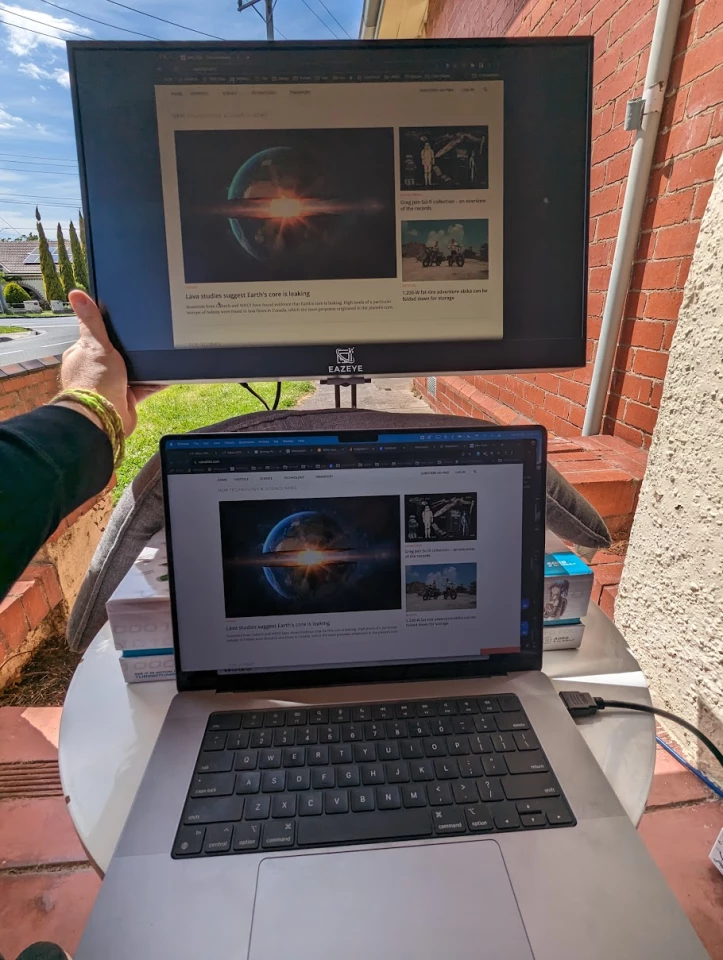
As somebody that doesn't suffer from the kind of eye strain in question, I can appreciate how a lower light level might be more relaxing to look at, and it's interesting how aggressively white and harsh my regular screens look when I switch them back on.
On the other hand, moving from the Eazeye's 1080p HD display to a sharper 2K monitor makes text easier to read in my case.
"With all LCD screens," says Huang, "the light that's transmitted through fro the backlight is really low, it's like a couple percent. We've tested a lot of LCD panels, different brightness-enhancing films, different sheets, diffusers ... This is the solution with the highest light admittance. We could get more light through with a lower resolution, but we can't do 2K. It's as good as it gets right now."
Huang agrees that it's a tough sell to folk that can handle looking at a brighter, harsher screen all day, who will look at this monitor and think it just looks dim and yellowed – but he says the folk that need this kind of thing will understand what it's going for.
"For people looking for solutions like e-ink or RLCD, this is a step forward," he says. "Depending on how your room is lit, it's an alternative, and if you're looking at price, color and refresh rate, it's one of the better ones. It's not perfect, but it's a step towards perfect from what's out there right now.
"There are people out there," he continues, "in Facebook and WhatsApp communities saying 'I can't work, because I can't look at regular monitors.' So I'm pushing to get started as soon as possible so I can deliver to those people and give them an affordable alternative."
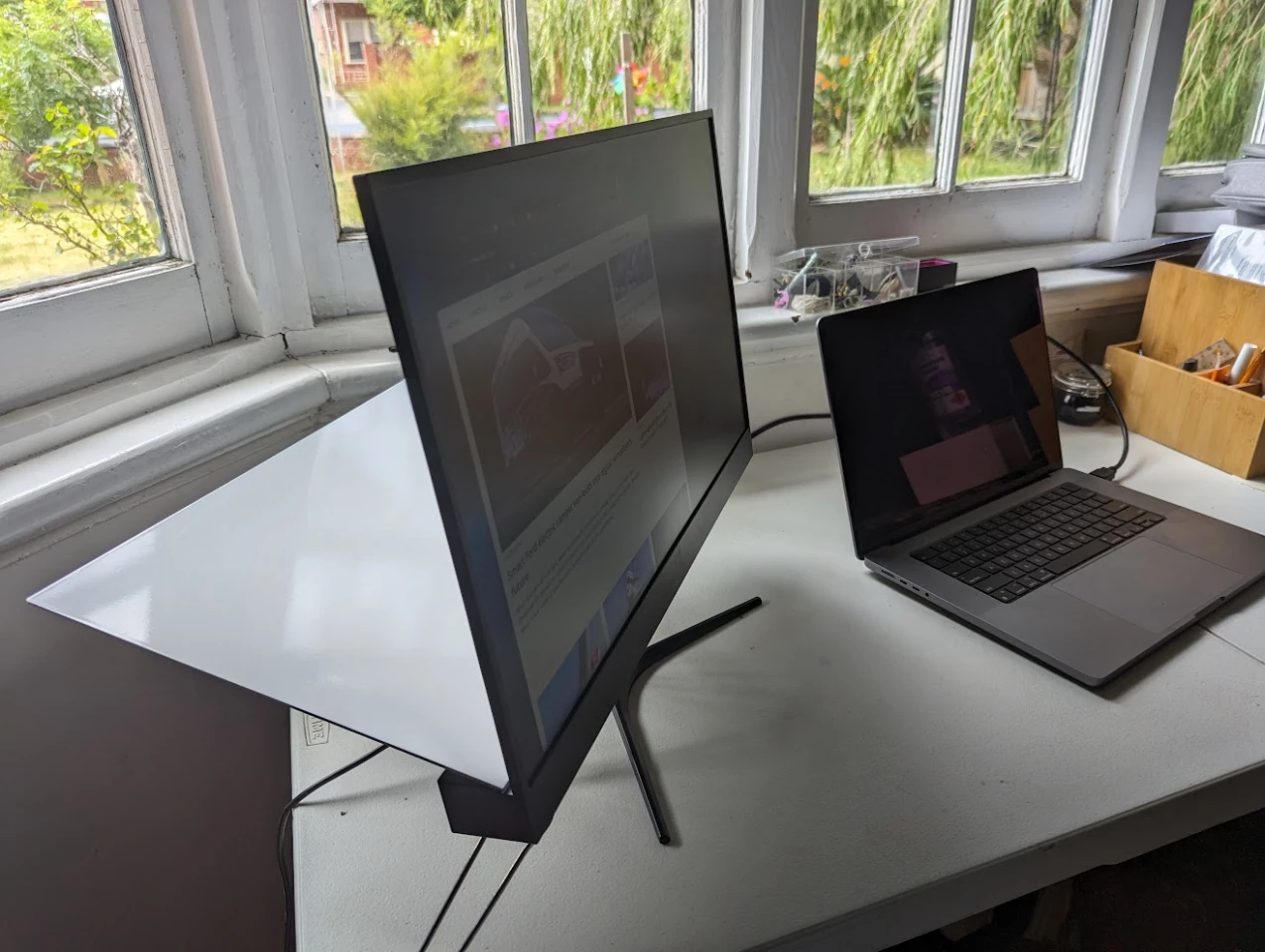
As such, my opinion as one of the unafflicted should be taken with a grain of salt. I've asked around looking for friends who find eye strain a serious problem, and we'll either update this piece or run a second review if and when the appropriate person has had a chance to work with it.
At $549, it's a premium over a regular monitor, but less than a third the cost of a similarly sized e-ink or RLCD screen. It requires a pretty specific room layout, lighting conditions will change during the day, and there's some fiddling to be done at night. I'm not 100% convinced you can't just turn your regular monitor's brightness down until it's no longer the brightest thing in the room, and pull out some blues from your color balance to achieve a similar effect, but I'll be interested to hear what eye strain sufferers think.
The Eazeye monitor is now live on Indiegogo, where it's already well past its fundraising goal and on the way to production. Standard crowdfunding cautions apply, although Huang strikes me as spectacularly organized for a high school student. At his age, I was more interested in making crude anatomical sketches on my friends' test papers than starting accessibility-focused manufacturing operations and designing innovative products like this one. It's been a huge journey getting the Eazeye this far, and I'm sure we'll be hearing more from this young man in the future.
Source: Indiegogo












